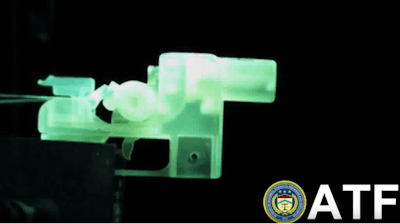
WASHINGTON (AP) — President Donald Trump says he is consulting with the National Rifle Association over whether it makes sense for a Texas company to publish downloadable blueprints for a 3D-printed gun.
Trump tweeted Tuesday he is "looking into 3-D Plastic Guns being sold to the public," adding that he "already spoke to NRA."
The president expressed doubt, saying "doesn't seem to make much sense!" He did not offer further details.
Trump spoke after eight states filed suit against the administration, contending the hard-to-trace plastic weapons are a boon to terrorists and criminals and threaten public safety.
The suit, filed Monday in Seattle, asks a judge to block the federal government's late-June settlement with Defense Distributed, which allowed the company to make the plans available online.
In a video from 2013, the federal Bureau of Alcohol, Tobacco, Firearms and Explosives tested one of the guns produced from Cody Wilson, the creator of the Liberator 3D-printed gun, and the owner of Defense Distributed.
In the video, the gun disintegrates into pieces after a single round was fired.
Joining the suit were Democratic attorneys general in Massachusetts, Connecticut, New Jersey, Pennsylvania, Oregon, Maryland, New York and the District of Columbia. Separately, attorneys general in 21 states urged Secretary of State Mike Pompeo and Attorney General Jeff Sessions on Monday to withdraw from the settlement with Defense Distributed, saying it "creates an imminent risk to public safety."
People can use the blueprints to manufacture a plastic gun using a 3D printer. But gun industry experts have expressed doubt that criminals would go to the trouble, since the printers needed to make the guns are very expensive, the guns themselves tend to disintegrate quickly and traditional firearms are easy to come by.
Unlike traditional firearms that can fire thousands of rounds in their lifetime, experts say the 3D-printed guns normally only last a few rounds before they fall apart. They don't have magazines that allow the usual nine or 15 rounds to be carried; instead, they usually hold a bullet or two and then must be manually loaded afterward. And they're not usually very accurate.
Cody Wilson first published downloadable designs for a 3D-printed firearm in 2013. It was downloaded about 100,000 times until the State Department ordered him to cease, contending it violated federal export laws since some of the blueprints were downloaded by people outside the United States.
The State Department reversed course in late June, agreeing to allow Wilson to resume posting the blueprints. The files were published on Friday.
The company filed its own suit in Texas on Sunday, asserting that it's the victim of an "ideologically fueled program of intimidation and harassment" that violates the company's First Amendment rights.
Meanwhile, Defense Distributed agreed to block temporarily Pennsylvania residents from downloading the plans after state officials went to federal court in Philadelphia on Sunday seeking an emergency order. The company said it has also blocked access to users in New Jersey and Los Angeles.






















